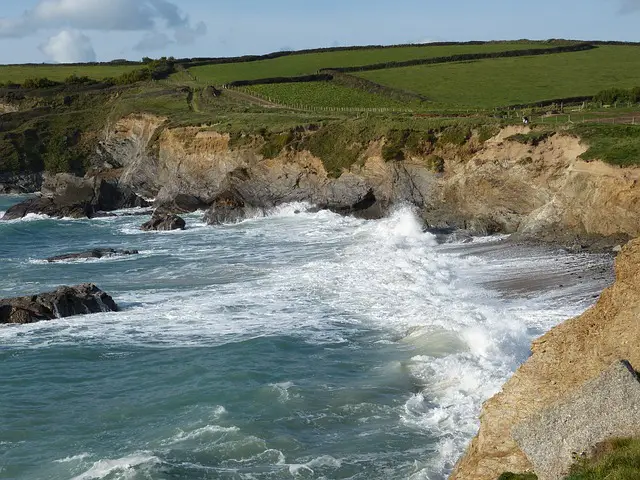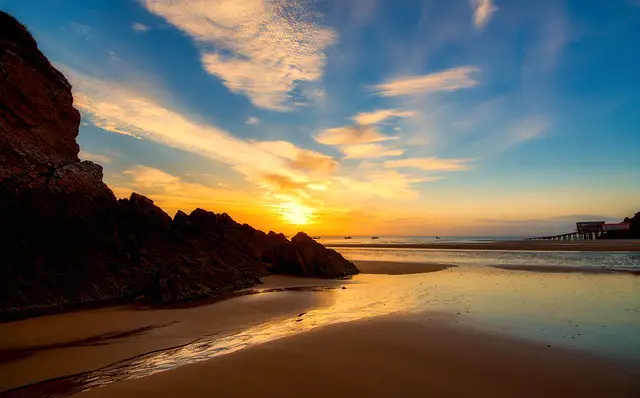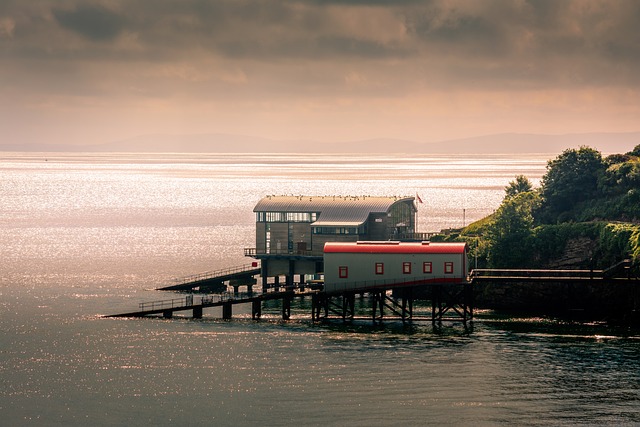High tide is when the sea level is at its highest, covering more shore. Low tide is when it’s lowest, exposing more shore. They cycle daily due to gravitational pull from the moon and sun.
TL;DR High Tide Vs. Low Tide
High tide refers to the peak of the tidal cycle when water reaches its highest level along the shoreline. It is influenced by various factors, including the gravitational pull of the moon and sun, the alignment of these bodies with the Earth, and the geography of the coastline.
Low tide is the opposite of high tide, representing the lowest level of water along the shoreline during the tidal cycle. It is also affected by gravitational forces and coastal geography.
Understanding Tides
Tides are the rise and fall of sea levels caused by the gravitational forces of the moon and the sun. Understanding the difference between high tide and low tide is crucial for coastal navigation, fishing, and other marine activities. Here’s a brief explanation:
High Tide: High tide is the point in the tidal cycle where the sea level reaches its highest point. During high tide, the ocean covers more of the shoreline, and water levels are at their peak. This occurs approximately twice a day.
Low Tide: Low tide is the opposite of high tide and occurs when the sea level reaches its lowest point. During low tide, more of the shoreline is exposed as water levels recede. This also occurs approximately twice a day.
The timing and height of high tide and low tide vary depending on the location and the gravitational pull of the moon and the sun. Factors such as the shape of the coastline, the depth of the ocean, and local weather conditions can also influence the tides.
What Causes Tides?
Tides, the ebb and flow of the ocean, have fascinated humans for centuries. In this section, we’ll uncover the intriguing factors that cause these natural phenomena. From the subtle dance between gravity and the Earth’s water, to the powerful gravitational pull of the moon and sun, we’ll explore the forces at play that give rise to high and low tides. Get ready to dive into the science behind this mesmerizing spectacle of nature!
The Role of Gravity
The Role of Gravity is crucial in understanding tides. Gravity is what controls the movement of water on Earth, causing the phenomenon of high tides and low tides.
The Role of Gravity is the force that attracts objects towards each other. In the case of tides, the gravitational pull from both the Moon and the Sun plays a significant Role. Although the Sun is much larger than the Moon, its influence on tides is about half as strong due to its distance from Earth.
The Moon’s gravitational force is responsible for the majority of tidal effects. As the Moon orbits around Earth, its gravitational pull causes a bulge of water on the side of Earth facing the Moon. On the opposite side of the Earth, there is another bulge due to the centrifugal force caused by the Earth-Moon system’s rotation.
The combined effect of these gravitational forces creates the regular pattern of two high tides and two low tides each day. The position of the Moon and its alignment with the Sun determine the specific timing and height of tides.
Understanding the Role of Gravity is essential for predicting tides accurately. This knowledge helps coastal communities prepare for potential flooding during high tides or take advantage of low tides for activities such as beachcombing or clam digging.
The Influence of the Moon and Sun
The moon and sun have a significant influence on the tides. Their gravitational pull plays a key role in the rise and fall of the ocean levels.
The Influence of the Moon and Sun:
The moon’s gravitational force is approximately two times stronger than that of the sun, making it the primary driver of tides. As the moon orbits around the Earth, its gravitational pull creates a bulge of water on the side of the Earth facing the moon. This results in a high tide. On the opposite side of the Earth, there is also a high tide as the moon’s gravitational force pulls the Earth away from the water.
The sun’s gravitational force also contributes to the tides, although to a lesser extent. When the sun and moon align, their combined gravitational force enhances each other, resulting in what is known as spring tides. During these times, the high tides are higher and the low tides are lower. Conversely, when the sun and moon are at right angles to each other, their gravitational forces partially cancel each other out, resulting in neap tides where the difference between high and low tides is less pronounced.
The influence of the moon and sun on tides is crucial in determining the water levels along coastlines and in estuaries. Understanding their influence is important for various activities like fishing, boating, and coastal management.
What Is High Tide?

Explore the mesmerizing world of high tides in our section on “What Is High Tide?” Discover the true meaning behind this natural phenomenon and uncover the various factors that influence the height of high tides. From the gravitational pull of the moon to the Earth’s rotation, we’ll unveil the secrets of high tides that shape our coastal landscapes. Hang on tight as we dive into the captivating realm of oceanic dynamics!
Definition of High Tide
High tide, also known as the peak of the water level during a tidal cycle, is a crucial concept in comprehending tides and their impact on coastal areas. It occurs when the water level in a body of water, like the ocean or a large lake, reaches its highest point, covering more of the shore and potentially reaching areas that are typically dry during low tide.
The straightforward definition of high tide depends on various factors, including the gravitational pull of the moon and sun, the shape of the coastline, and the depth and width of the body of water. These factors contribute to the variability of high tide, which happens approximately twice a day and can be predicted using tide charts. The exact height of high tide varies greatly based on location and other influencing elements. While in some regions it may only cause a slight increase in water level, in others it can lead to a noticeable rise, submerging docks and flooding coastal areas.
To coastal residents and individuals involved in activities like boating, fishing, or beach recreation, understanding the definition of high tide is crucial. It enables them to plan their activities accordingly and be aware of potential risks associated with higher water levels.
Factors Affecting the Height of High Tide
Factors affecting the height of high tide involve several key elements. These factors include the gravitational pull of the moon and sun, the shape and depth of the coastline, and the presence of obstacles such as islands or sandbars.
The gravitational force exerted by the moon and sun on Earth’s oceans creates a bulge of water, resulting in high tides. However, the moon has a greater influence due to its close proximity to Earth. When the gravitational pulls of the moon and sun align, it leads to spring tides, causing higher high tides. Conversely, when the gravitational pulls are at right angles, neap tides occur, resulting in lower high tides.
In addition to celestial influences, the shape and depth of the coastline also play a vital role in determining the height of high tide. Coastlines that are shallow and sloping tend to experience larger variations between high and low tide, leading to higher high tides. On the other hand, steep or narrow coastlines may have smaller variations, resulting in lower high tides.
The presence of obstacles, such as islands or sandbars, can significantly affect the flow of water and consequently create localized variations in high tide heights. Water encounters these hindrances, which can divert its path around them, leading to water piling up and generating higher high tides in specific areas.
Understanding these factors is of utmost importance for coastal communities and industries that rely on tidal patterns. They depend on these patterns for activities like fishing, navigation, and recreation. By taking into account the factors affecting the height of high tide, these stakeholders can better plan their activities and mitigate potential risks associated with tidal fluctuations.
What Is Low Tide?

During low tide, a mesmerizing phenomenon unfolds as the ocean magically recedes and reveals a hidden landscape. In this section, we’ll plunge into the enchanting world of low tide, exploring its definition and uncovering the various factors that influence its depth. Get ready to embark on a journey filled with intriguing natural patterns and fascinating revelations about the ebb and flow of the sea.
Definition of Low Tide
Low tide, which occurs twice a day, is defined as the point in the tidal cycle when the water level is at its lowest. It can vary in depth depending on various factors. One important factor influencing the depth of low tide is the gravitational pull of the moon and the sun. When the gravitational forces of these celestial bodies align, it creates a stronger gravitational pull on the Earth’s oceans, resulting in higher high tides and lower low tides. The alignment of the moon, sun, and Earth also affects the timing and intensity of low tides.
Other factors that influence the depth of low tide include the shape of the coastline, the slope of the ocean floor, and the presence of underwater features like sandbars or reefs. These factors can cause the low tide to be more shallow or more pronounced in certain areas.
Understanding the definition of low tide is important for activities such as beachcombing, fishing, and boating. During low tide, areas that are usually submerged may become accessible, allowing people to explore tidal pools and uncover hidden treasures. It’s crucial to be aware of the changing tides to avoid getting stranded or caught in rising waters.
To make the most of low tide, check tide charts or consult local authorities to find out the specific times and depths of low tide in your area. This information will help you plan your activities and ensure a safe and enjoyable experience by the water.
By understanding low tide and its variations, you can make informed decisions and fully enjoy coastal activities.
Factors Affecting the Depth of Low Tide
| Factors Affecting the Depth of Low Tide |
| 1. Distance from the Moon |
| The depth of low tide is influenced by the distance between the Earth and the Moon. When the Moon is closer to Earth, gravitational forces are stronger, causing a greater difference between high tide and low tide. This results in a deeper low tide. |
| 2. Lunar Phases |
| The phase of the Moon also affects the depth of low tide. During a full or new moon, when the Earth, Moon, and Sun are aligned, the gravitational pull is stronger, causing higher high tides and lower low tides. In contrast, during the first and last quarter moon, the gravitational forces are less pronounced, resulting in less variation between high tide and low tide. |
| 3. Topography of the Coastline |
| The shape and features of the coastline play a role in determining the depth of low tide. For example, a steep and narrow coastline will experience a more significant drop in water level during low tide compared to a gently sloping coastline. The presence of underwater structures such as sandbars or reefs can affect the flow of water and contribute to variations in low tide depth. |
Pro-tip: If you’re interested in exploring the coastline during low tide, it’s advisable to consult tide charts or local tide predictions to ensure you have accurate information on the depth of low tide. This will help you plan your activities and make the most of your coastal adventures.
What Are the Differences Between High Tide and Low Tide?
Water Level
The water level during high tide and low tide is an important aspect to understand in the context of tides. Here is a table summarizing the water level during these tidal events:
| Tidal Event | Water Level |
| High Tide | The water level during high tide is at its highest point along the coastline. |
| Low Tide | The water level during low tide is at its lowest point along the coastline. |
During high tide, the water level rises significantly, reaching its peak. This occurs when the gravitational forces of the moon and sun align, leading to a stronger pull on the Earth’s oceans. As a result, water is pushed towards the shore, causing the water level to rise.
In contrast, during low tide, the water level decreases and reaches its lowest point. This happens when the gravitational forces of the moon and sun are not aligned, resulting in a weaker pull on the Earth’s oceans. As a result, water recedes away from the shore, causing the water level to drop.
Understanding the changes in water level during high and low tide is crucial for various activities, such as navigation, coastal engineering, and recreational beach activities. It is important to take into account the water levels during these tidal events to ensure safety and effectively plan activities along the coastline.
Time of Occurrence
The time of occurrence of high tide and low tide can vary depending on several factors. One way to understand this is by looking at a table that depicts the time of occurrence for both high tide and low tide.
| Location | High Tide Time | Low Tide Time |
| Beach A | 12:30 PM | 6:45 AM |
| Beach B | 1:15 PM | 7:00 AM |
| Beach C | 2:00 PM | 7:15 AM |
The table above demonstrates how the time of high tide and low tide can vary from one location to another. It is important to note that these timings are not fixed and can change on a daily basis. The time of occurrence is influenced by various factors including the gravitational pull of the moon and the sun, as well as the geography of the specific location.
Understanding the time of occurrence helps individuals plan their activities accordingly. For example, if you enjoy beach activities such as swimming or surfing, it is ideal to visit the beach during the time of occurrence of high tide as it offers favorable conditions. On the other hand, during the time of occurrence of low tide, certain areas may become accessible for exploring tidal pools or collecting seashells.
By considering the time of occurrence of high tide and low tide, individuals can make the most of their beach visits and enjoy the different experiences that each tide brings.
Impact on Coastal Ecosystems
High tides and low tides have a substantial impact on coastal ecosystems. This impact can be observed in various ways.
- Marine life: The influence of high tides and low tides on coastal ecosystems is evident in their effect on marine organisms, including fish, crabs, and mollusks. During high tides, these organisms have greater access to water and are able to move more freely, providing them with increased opportunities for feeding and breeding. Conversely, during low tides, the retreating water limits their mobility and restricts their access to food and shelter.
- Intertidal zones: High tides submerge intertidal zones, which are the areas situated between high and low tides. These zones serve as significant habitats and are home to a diverse array of species. When high tides occur, intertidal organisms are exposed to a wider range of resources and opportunities. In contrast, low tides expose these organisms to unfavorable conditions, such as extreme temperatures and increased predation risks.
- Nutrient distribution: The impact of high tides and low tides on coastal ecosystems can also be observed through nutrient distribution. High tides bring nutrients from the ocean into coastal areas, supporting the growth of plants and algae that form the foundation of the coastal food chain. During low tides, these nutrient-rich areas become exposed, allowing for nutrient absorption and circulation within the ecosystem.
- Erosion and sedimentation: High tides have the potential to contribute to coastal erosion as the force of the waves wears away the land. This erosion directly affects the stability of coastal habitats. Conversely, during low tides, sediments settle and accumulate, influencing the coastal landscape and providing habitat for various organisms.
The impact of high tides and low tides on coastal ecosystems is significant. It affects the distribution of marine life, availability of nutrients, structure of habitats, and patterns of erosion. Understanding these impacts is crucial for conservation efforts and the sustainable management of coastal ecosystems.
Frequently Asked Questions
What is the definition of tidal force?
The tidal force refers to the gravitational pull exerted by celestial bodies like the moon and sun on the ocean waters, resulting in the rise and fall of tides.
What are the key differences between high tide and low tide?
High tide occurs when the seawater rises to its maximum level, covering a larger area of the shore. On the other hand, low tide corresponds to the seawater drawing back to its lowest level and flowing towards the sea.
What are the similarities between high tide and low tide?
Both high tide and low tide are reliable natural phenomena that occur twice a day due to the gravitational pull of the moon and sun. They involve the regular rise and fall of ocean waters.
What is the tidal range?
The tidal range refers to the difference in height between high tide and low tide. It signifies how much the sea level changes during the tide cycle.
What is slack water or slack current?
Slack water or slack current refers to the period between the flood and ebb currents when the tidal currents are at their weakest. During this time, there is little to no horizontal movement of water.
What are diurnal, semi-diurnal, and mixed tides?
Diurnal tides consist of one high tide and one low tide in a 24-hour period. Semi-diurnal tides have two high tides and two low tides of similar heights in a 24-hour period. Mixed tides display a varying pattern, with two high tides and two low tides, but the heights may be significantly different.
Image Credits
Featured Image By – Tim Hill from Pixabay
Image 1 By – laroberts58 from Pixabay
Image 2 By – Tim Hill from Pixabay








